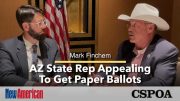
In its 58-page ruling by the U.S. Fifth Circuit Court of Appeals, a three-judge panel — all Trump appointees — took the Bureau of Alcohol, Tobacco, Firearms and Explosives (ATF) to the woodshed. The agency cannot legislate. It cannot rewrite or reinterpret or expand on laws passed by Congress to fit its own — and the present administration’s — anti-gun agenda.
Thursday’s ruling opened by declaring that the ATF’s vendetta against so-called ghost guns was illegal:
[The] law-making power — the ability to transform policy into real-world obligations — lies solely with the legislative branch.
Where an executive agency engages in what is, for all intents and purposes, “law-making,” the legislature is deprived of its primary function under our Constitution, and our citizens are robbed of their right to fair representation in government.
This is especially true when the executive rule-turned-law criminalizes conduct without the say of the people who are subject to its penalties.
The agency rule at issue here flouts clear statutory text and exceeds the legislatively-imposed limits on agency authority in the name of public policy.
Because Congress has neither authorized the expansion of firearm regulation nor permitted the criminalization of previously lawful conduct, the proposed rule constitutes unlawful agency action, in direct contravention of the legislature’s will.
The panel ruling against the ATF was just warming up:
It is axiomatic that an administrative agency’s power to promulgate legislative regulations is limited to the authority delegated by Congress.…
Agencies … must point to explicit Congressional authority [in] justifying their decisions.
Words matter:
How do we know when an agency has exceeded its statutory authority? Simple: the plain language of the statute tells us so.
The panel then pointed to the impact that the Supreme Court’s ruling in Bruen (New York State Rifle & Pistol Association, Inc. v. Bruen) has in calling out the ATF:
After almost fifty years of uniform regulation, ATF, via [its] Final Rule, now purports to expand the terms “frame” and “receiver,” as they were understood in 1968, to include changes in firearms in modern times.
But the meanings of statutes do not change with the times. This Court normally interprets a statute in accord with the ordinary public meaning of its terms at the time of its enactment. After all, only the words on the page constitute the law adopted by Congress and approved by the President. [Emphasis in original.]
But the rogue agency ignored Bruen and proceeded with its plan to require ghost guns and their parts and pieces to have ID numbers on them so that — says the agency — law enforcement can do a better job of enforcing existing laws:
ATF’s inclusion now of “partially complete, disassembled, or nonfunctional” frames and receivers materially deviates from past definitions of these words to encompass items that were not originally understood to fall within the ambit of the GCA [Gun Control Act of 1968].
The panel then quoted from a ruling elsewhere that reflected Bruen:
“[W]ords generally should be interpreted as taking their ordinary meaning at the time Congress enacted the statute” because “if judges could freely invest old statutory terms with new meanings, we would risk amending legislation outside the single, finely wrought and exhaustively considered, procedure the Constitution commands.”
… As such, the proposed definition is an impermissible extension of the statutory text approved by Congress.
This is the lesson taken from this ruling last week: A rogue agency will seek always and forever to expand its powers until it is reined in by a separate branch of government.
The judges then excoriated the agency for claiming, in its defense, that it had expanded definitions in the past without sanctions being applied. Wrote the panel:
Simply because [the] ATF may have acted outside of its clear statutory limits in the past does not mandate a decision in its favor today.
In a relevant footnote, the judges noted that the agency had tried to gain even more power by adding additional language to reach the users of 3D printers, but decided at the last minute not to push that far. Here is that footnote:
Perhaps noticing the error in its incredibly broad and murky proposal, ATF affirmatively excluded from the definition’s scope “a forging, casting, printing, extrusion, unmachined body, or similar article that has not yet reached a stage of manufacture where it is clearly identifiable as an unfinished component part of a weapon (e.g., unformed block of metal, liquid polymer, or other raw material.).”
ATF’s attempt to carve out this vague laundry list of unfinished products further demonstrates that the proposed definition lacks any objective hook in the statute.
But what the ATF intended was bad enough, and the court called the agency out on it: “Because it clearly conflicts with the plain language of the GCA, the challenged portion of the Final Rule that redefines ‘frame or receiver’ to include partially complete, disassembled, or nonfunctional frames or receivers constitutes unlawful agency action.”
In their conclusion, the judges wrote about those building firearms at home:
Consider the long-standing tradition of at-home weapon-making in this country. We assume Congress was familiar with the relevant historical context when writing the GCA, yet Congress made no clear reference to aggregations of weapon parts … in the text of the GCA.
Rather, as noted above, Congress clearly stated that the GCA “is not intended to discourage or eliminate the private ownership or use of firearms by law-abiding citizens for lawful purposes.”
But the ATF ignored that and moved ahead anyway, seeking to criminalize what was, and had been, legal in this country for decades:
ATF has cast a wider net than Congress intended: under the Final Rule, the GCA will catch individuals who manufacture or possess not just functional weapons, but even minute weapon parts that might later be manufactured into functional weapons.
The Final Rule purports to criminalize such conduct and impose fines, imprisonment, and social stigma on persons who, until the Final Rule’s promulgation, were law-abiding citizens.
ATF cannot so transform the GCA to include aspects of the nation’s firearm industry that were previously — and purposefully — excluded from the statute.
The three-judge panel reined in the rogue agency:
ATF’s proposed definition is not only imprecise, ambiguous, and violative of the statutory text, it also legislates.
Thus, the challenged portion of the Final Rule that redefines “firearm” to include weapon parts kits constitutes unlawful agency action.
In conclusion:
ATF, in promulgating its Final Rule, attempted to take on the mantle of Congress to “do something” with respect to gun control.
But it is not the province of an executive agency to write laws for our nation. That vital duty, for better or for worse, lies solely with the legislature.
Only Congress may make the deliberate and reasoned decision to enact new or modified legislation regarding firearms based on the important policy concerns put forth by ATF and the various amici here.
But unless and until Congress so acts to expand or alter the language of the Gun Control Act, ATF must operate within the statutory text’s existing limits.
The Final Rule impermissibly exceeds those limits, such that ATF has essentially rewritten the law.
This it cannot do, especially where criminal liability can — and, according to the Government’s own assertions, will — be broadly imposed without any Congressional input whatsoever.
An agency cannot label conduct lawful one day and felonious the next — yet that is exactly what ATF accomplishes through its Final Rule. Accordingly, the judgment of the district court is AFFIRMED….
Given the agency’s propensity to seek additional illegal powers for itself, it is reasonable to expect it to appeal this ruling to the Supreme Court.



